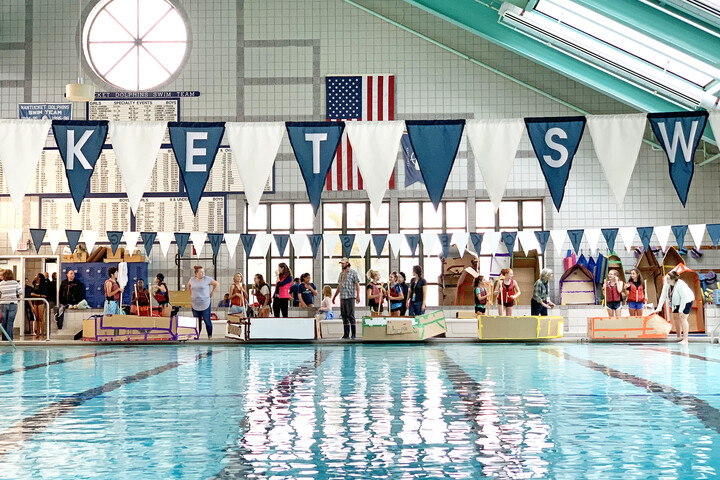
The Highly-Anticipated Fall Regatta Moved to the Nantucket Community Pool
By Olivia E. Jackson
On Thursday, October 10, for the first time in the history of the Cardboard Boat Race, eighth graders from Cyrus Peirce Middle School raced their cardboard constructed vessels at the Nantucket Community Pool instead of its traditional location at Children’s Beach. Inclement weather, which consisted of 20 foot waves off Nantucket shores and incessant rain for four days, forced the annual race to be moved to a safer, more controlled body of water. However, the entertainment, enthusiasm, and energy from both the students and spectators could hardly be contained; the Community Pool was the perfect alternative race venue.
The 2019 Cardboard Boat Race at the Nantucket Community Pool.
In its sixth year, the Sea of Opportunities (SOO) year-long core eighth grade class, Oceanography and Maritime Studies, emphasizes hands-on projects and experiential learning opportunities, giving all students the chance to find academic success and confidence in the classroom. At the start of every school year, Dr. Amanda Bardsley, the eighth grade SOO educator, begins her class with several introductory experiments and fundamental lessons that encourage students to think about their preconceived notions of science and scientists. Her goal is to illuminate and underscore that any student can pursue studies or careers in science, technology, mathematics, or engineering fields.
The Cardboard Boat Race is the culmination and final task in the first unit in the eighth grade class. The Cardboard Boat Engineering Design Project sets the tone, academic model, and desired goals for the overarching framework of the class; it incorporates team building, collaboration and experiential learning with a traditional oceanography curriculum and lessons about Nantucket’s seafaring history and maritime culture. This first unit allows students to apply the information they learned directly to a hands-on project.
The students' seaworthy cardboard boats lined up before the race.
The students start this section by building manila folder boats, in which they customize the hull shapes, and analyze the glide length and maneuverability of the rudimentary vessel. They proceed to research what methods and ideas have been used previously to construct a viable, durable boat before beginning to build cardboard models of their designs. These small-scale models illuminate the various manipulative qualities of different materials, and how a change in resources can drastically impact the shape of the hull, speed of the vessel, and overall floatability. The models allow the students to gather their ideas, execute them on a small scale, and recognize what works and what doesn’t before building their larger vessels.
In preparation for the final build, students are assigned roles in their teams: there is the Boat Architect, who is in charge of drawing the different boat designs; the Construction Manager, who is in charge of cutting and folding the cardboard; the Tape Manager, who dictates how much tape is used and where to strategically put it; and the Glue Manager, who is in charge of reinforcing the boat. According to Dr. Bardsley, the students “need to all work together in order to create a good boat.” Throughout this whole process, from the manila folder boats to the final seaworthy vessels, the students are learning the multiple stages and steps in the engineering design cycle. The annual Cardboard Boat Race is the final phase: the test.
Boatloads of fun for all.
On Thursday, October 10, at 1pm, the first heat of boats entered the temperate, chlorinated water. The students were tasked with paddling to the middle of the pool, turning around, and returning to the starting end in the quickest amount of time possible. Using wooden oars and in heats of four or five boats, the eighth graders ploughed through the water, racing to complete the 25 yard course and hoping that their cardboard vessel successfully finished while their classmates in the gallery cheered for their respective teams. It was a highly entertaining, boatload of fun, and a special educational experience for island students and spectators. The annual Cardboard Boat Race is one of the most memorable events in the fall, and Egan Maritime is grateful to everyone who helped make the race happen, kept the students safe, and supported local youth and their experiential learning projects.
Complete Race Video
Race Awards
First Place Team: Braden, Shelby, Brooke, and Erishel
Second Place Team: Hawkin, Tashe, Aubrey, Jack H., and Bryan
Third Place Team: Michael, Edgar, Sydney A., and Lily F.
Most Dramatic Shipwreck: Colin, Claire and Katie
With Gratitude
Sea of Opportunities would not be possible without the generous contributions, thoughtful participation, and dedicated support of our donors, partners, foundations, and island businesses. The Cardboard Boat Race was an immense success and boatloads of fun thanks to the following individuals and businesses:
John Buckey; Island Kitchen; Sheila Lucey, Harbor Master; Kris Dagesse; Marine Home Center; Jim Pignato; Joe Perry, Nantucket Public Schools; Jen Psaradelis; Reis Trucking; Tracy Roberts; The Juice Bar; The Nantucket Community Pool; Nantucket Community Sailing; Nantucket Golf Club Foundation; Town of Nantucket Lifeguards; Mark Gonella; Maura Wendelken and the eighth grade teaching team: Beau Almodobar, Alyssa Billings; Lena Civitarese; Chip Davis; Dan Farrell; Susan Haford; Karin MacLellan; Jason Mleczko; Kathryn Norton; Marita Scarlett, Rachel Sullivan.